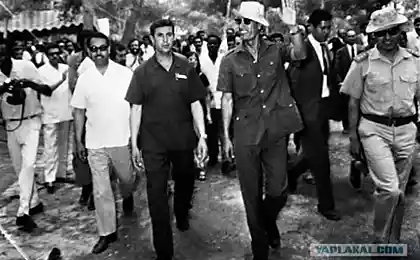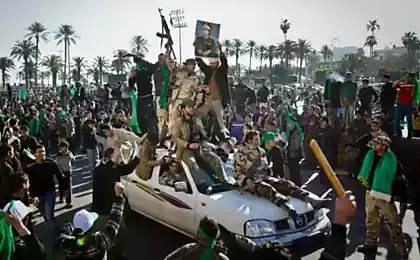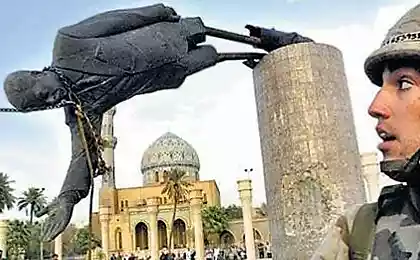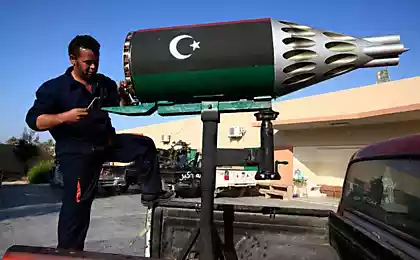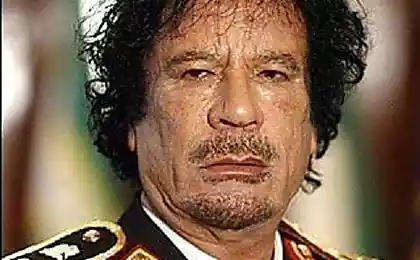1382
Gaddafi grand water project
The Great Man-Made River - the greatest in its ambitious project of Libya - is a network of water pipes that supply water-free industrial areas and the northern part of Libya with clean drinking water from underground storage tanks oasis, located in the southern part of the country. According to independent experts, the world's largest engineering project of the existing at the moment. A little-known project because Western media hardly covered him, and yet the project surpassed its value for the world's largest construction event: project cost $ 25 billion.
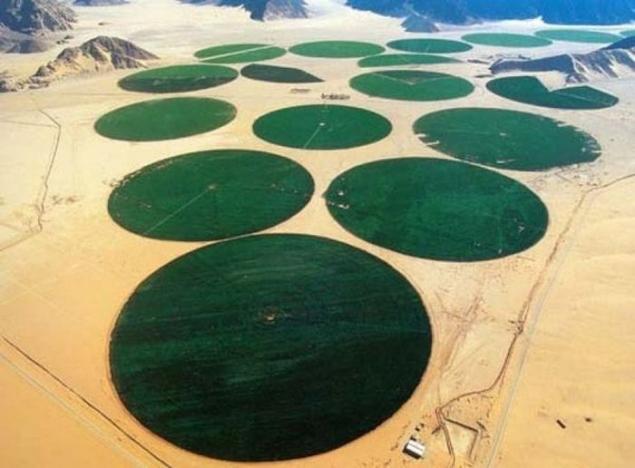
Gaddafi started the project back in the 80s and at the beginning of the current fighting, he was practically implemented. It should be noted in particular: the construction of the system was not spent a cent of foreign money. And this fact is certainly suggestive, because control over water resources is becoming increasingly significant factor in world politics. Is the current war in Libya, the first war of the drinking water? It does have to fight for it! The functioning of the man-made river based on water intake of 4 huge water reservoirs located in the oases Hamada, Kufra, Morzuk and Sirt and containing approximately 35,000 cubic meters. kilometers of well water! This volume of water could fully cover the territory of a country like Germany, with the depth of the reservoir would be about 100 meters. And according to recent research, the Libyan water artesian springs enough for about 5,000 years.
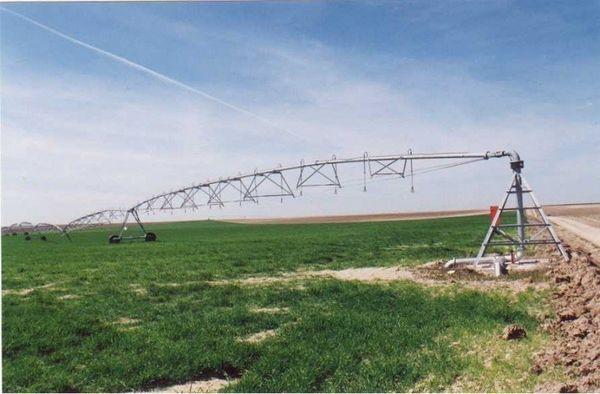
In addition, this water project on the scales can rightly be called "the eighth wonder of the world" because it provides transportation within 6, 5 million cubic meters of water per day through the desert, a stunning way that increases the area of irrigated desert lands. Man-made river project is absolutely not comparable to that carried out by Soviet leaders in Central Asia in order to irrigate its cotton fields and that led to the Aral Sea catastrophe. The principal difference between the Libyan irrigation project lies in the fact that for irrigation of agricultural land used is almost endless underground rather than surface water source, readily undergo extensive damage in a short period of time. Transport water is closed manner by using four thousand kilometers steel pipes buried deep in the ground. Water is pumped from artesian pools of 270 mines from a depth of several hundred meters. One cubic meter of crystal clear water of the Libyan underground reservoirs, taking into account all the costs of its production and transportation of treated Libyan government just 35 cents, which is roughly comparable to the cost of a cubic meter of cold water in large Russian cities, including Moscow. If we take into account the cost of a cubic meter of drinking water in Europe (about 2 euros), the cost of stocks of artesian water in the Libyan underground tanks is at most estimated that nearly 60 billion euros. Agree that this volume continues to rise in the price of the resource may be of interest is much more serious than the oil.
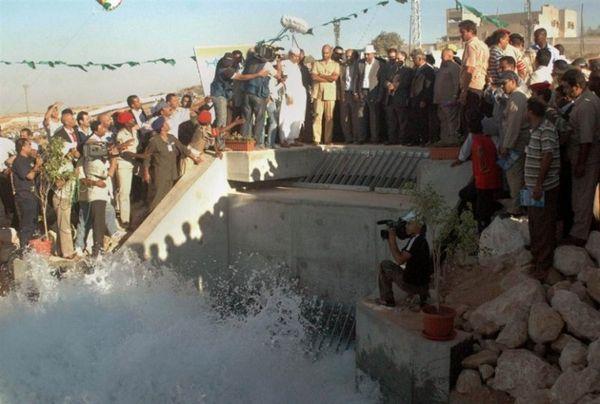
Before the war, Man-Made River irrigate about 160000ga actively reclaimed for agriculture. And to the south, on the territory of the Sahara, derived on the surface ditches are home watering animals. And most importantly, drinking water were provided with major cities of the country, particularly the capital Tripoli.
Here are the most important dates in the history of Libyan irrigation project "The Great Man-Made River" in 2008, recognized by Guinness world's largest:
• October 3 1983goda - it was convened by the General People's Congress of Libya, and held an emergency session, which was announced funding for the project.
• August 28, 1984 - Libyan leader to start laying the first stone of the construction of the project.
• August 26, 1989 - begins the second phase of construction of the irrigation system.
• 11 September 1989 - entered the water reservoir in Ajdabiya.
• September 28, 1989 - entered the water in the reservoir Grand Omar Muktar.
• September 4, 1991 - water enters the reservoir of Al-Gardabiya.
• On August 28, 1996 - the beginning of a regular supply of Tripoli.
• 28 September 2007 - the water came in Gharyan.
Due to the fact that neighboring Libya countries, including Egypt, are suffering from a shortage of water resources, it is logical to assume that the Jamahiriya with its water project was fully capable to significantly expand its influence in the region, starting in the neighboring countries of the green revolution and figurative and in the literal sense of the word, since due to irrigation fields, most of the North African power problems in Africa would be decided very quickly, provide the country with the region's economic independence. And the corresponding attempt took place. Gaddafi is actively encouraged the peasants of Egypt to come and work in the fields of Libya.
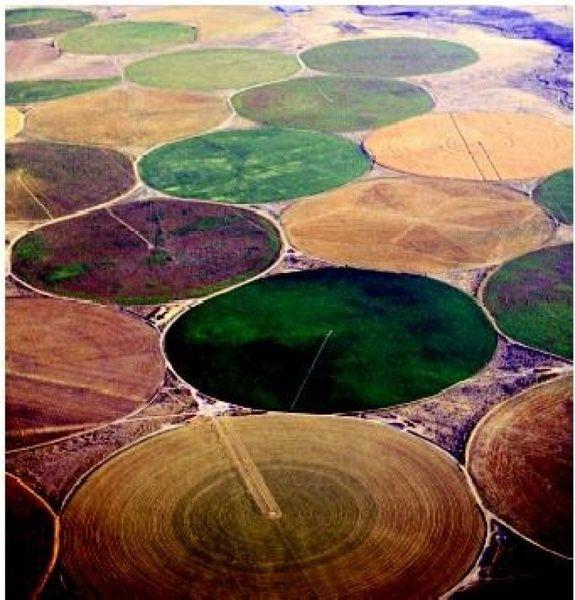
Water Project Libya was a real slap in the face throughout the West, after all, the World Bank and the US Department of State promote only their profitable projects such as seawater desalinizatsii project in Saudi Arabia, which costs $ 4 per cubic meter of water. It is obvious that the West is beneficial water scarcity - it maintains its high price.
It is noteworthy that, speaking at the celebration of the anniversary of the start of construction of the river, on September 1 last year, Gaddafi said: "Now that this achievement of the Libyan people became apparent threat to the United States against our country will double!" In addition, several years ago, Gaddafi said that Libyan irrigation project would be "the most serious answer to America, which constantly accuses Libya of sympathizing with terrorism and the existence of petrodollars." A very eloquent fact had the support of this project and the former Egyptian President Mubarak. And it is surely no coincidence.
Source: topwar.ru

Gaddafi started the project back in the 80s and at the beginning of the current fighting, he was practically implemented. It should be noted in particular: the construction of the system was not spent a cent of foreign money. And this fact is certainly suggestive, because control over water resources is becoming increasingly significant factor in world politics. Is the current war in Libya, the first war of the drinking water? It does have to fight for it! The functioning of the man-made river based on water intake of 4 huge water reservoirs located in the oases Hamada, Kufra, Morzuk and Sirt and containing approximately 35,000 cubic meters. kilometers of well water! This volume of water could fully cover the territory of a country like Germany, with the depth of the reservoir would be about 100 meters. And according to recent research, the Libyan water artesian springs enough for about 5,000 years.

In addition, this water project on the scales can rightly be called "the eighth wonder of the world" because it provides transportation within 6, 5 million cubic meters of water per day through the desert, a stunning way that increases the area of irrigated desert lands. Man-made river project is absolutely not comparable to that carried out by Soviet leaders in Central Asia in order to irrigate its cotton fields and that led to the Aral Sea catastrophe. The principal difference between the Libyan irrigation project lies in the fact that for irrigation of agricultural land used is almost endless underground rather than surface water source, readily undergo extensive damage in a short period of time. Transport water is closed manner by using four thousand kilometers steel pipes buried deep in the ground. Water is pumped from artesian pools of 270 mines from a depth of several hundred meters. One cubic meter of crystal clear water of the Libyan underground reservoirs, taking into account all the costs of its production and transportation of treated Libyan government just 35 cents, which is roughly comparable to the cost of a cubic meter of cold water in large Russian cities, including Moscow. If we take into account the cost of a cubic meter of drinking water in Europe (about 2 euros), the cost of stocks of artesian water in the Libyan underground tanks is at most estimated that nearly 60 billion euros. Agree that this volume continues to rise in the price of the resource may be of interest is much more serious than the oil.

Before the war, Man-Made River irrigate about 160000ga actively reclaimed for agriculture. And to the south, on the territory of the Sahara, derived on the surface ditches are home watering animals. And most importantly, drinking water were provided with major cities of the country, particularly the capital Tripoli.
Here are the most important dates in the history of Libyan irrigation project "The Great Man-Made River" in 2008, recognized by Guinness world's largest:
• October 3 1983goda - it was convened by the General People's Congress of Libya, and held an emergency session, which was announced funding for the project.
• August 28, 1984 - Libyan leader to start laying the first stone of the construction of the project.
• August 26, 1989 - begins the second phase of construction of the irrigation system.
• 11 September 1989 - entered the water reservoir in Ajdabiya.
• September 28, 1989 - entered the water in the reservoir Grand Omar Muktar.
• September 4, 1991 - water enters the reservoir of Al-Gardabiya.
• On August 28, 1996 - the beginning of a regular supply of Tripoli.
• 28 September 2007 - the water came in Gharyan.
Due to the fact that neighboring Libya countries, including Egypt, are suffering from a shortage of water resources, it is logical to assume that the Jamahiriya with its water project was fully capable to significantly expand its influence in the region, starting in the neighboring countries of the green revolution and figurative and in the literal sense of the word, since due to irrigation fields, most of the North African power problems in Africa would be decided very quickly, provide the country with the region's economic independence. And the corresponding attempt took place. Gaddafi is actively encouraged the peasants of Egypt to come and work in the fields of Libya.

Water Project Libya was a real slap in the face throughout the West, after all, the World Bank and the US Department of State promote only their profitable projects such as seawater desalinizatsii project in Saudi Arabia, which costs $ 4 per cubic meter of water. It is obvious that the West is beneficial water scarcity - it maintains its high price.
It is noteworthy that, speaking at the celebration of the anniversary of the start of construction of the river, on September 1 last year, Gaddafi said: "Now that this achievement of the Libyan people became apparent threat to the United States against our country will double!" In addition, several years ago, Gaddafi said that Libyan irrigation project would be "the most serious answer to America, which constantly accuses Libya of sympathizing with terrorism and the existence of petrodollars." A very eloquent fact had the support of this project and the former Egyptian President Mubarak. And it is surely no coincidence.
Source: topwar.ru

